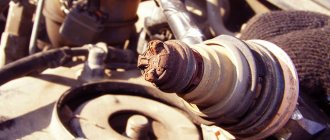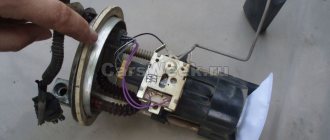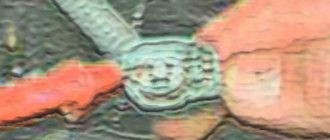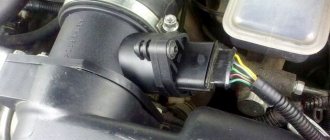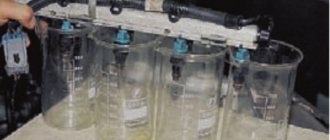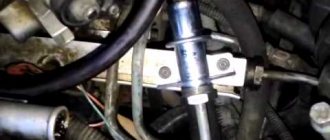Why don't the injectors work?
Nowadays, injectors are made to a tolerance of 1 micron, which allows them to carry out about a billion cycles. The main reason why their performance is impaired is contamination during operation , despite the fact that the path to any mechanical particles is blocked by filters that filter out particles larger than 10-20 microns. The place where the filters are installed is the fuel line and the injector itself. The main cause of contamination is the inevitable presence of heavy particles in the fuel. The largest accumulation of dirt occurs after the engine is turned off. At this moment, due to the fact that the nozzle is heated by the engine, the temperature of its body increases, while there is no cooling effect of the fuel. Light particles of fuel located in the nozzle evaporate, while heavy ones settle like varnish deposits, reducing the cross-section in the calibrated channel. For example, deposits 5 microns thick can reduce the capacity of a given channel by about 25%. Contamination of the holes in the injectors prevents the formation of the fuel mixture, the shut-off valve of the pressure regulator loses its tightness, and the high-pressure fuel pump in diesel engines reduces its performance.
Cleaning methods
Currently, there are two main cleaning methods:
- One of the simplest methods is to add a cleaning additive to the fuel through the gas tank, which dissolves deposits during operation. It is recommended to carry out such cleaning as a preventative measure approximately once every 5 thousand km. This method is only suitable if the car has low mileage. If the machine has been in use for a long time and the system is supposedly very dirty, such cleaning may only make the situation worse. When there is a lot of contaminants, it will not be possible to completely dissolve them with the help of additives, and the spray nozzles may become even more clogged. More deposits will get from the fuel tank into the fuel pump, which can cause it to break down.
- Another method requires special equipment and skills. A flushing device is connected to the injector through special adapter fittings. Instead of fuel, the device receives a special washing liquid such as: Wynn's, Liqui Moly, C arbom clean, etc., from a cylinder, which is connected by tubes. Thanks to the fitting, the system does not need: a fuel filter, a gas tank, a gas line, or an electric fuel pump. A mixture of cleaning fluid and gasoline is supplied to the engine under pressure. The supply pressure must be set according to the technical parameters of the specific engine. Under the influence of the washing liquid, contaminants become limp, pass through the nozzles and burn in the cylinders. The cleaning procedure lasts 30−50 minutes.
The main causes of injector contamination.
But the injectors of cars that are operated in the territory of the former USSR have to be cleaned every 15 - 30 thousand kilometers. There is only one reason for the poor quality of fuel - the desire to receive excess profits from the sale of fuel and lubricants. As a result:
- Insufficient capacity for the production of A-92 and A-95 gasoline, but A-98 at domestic gas stations is in most cases a myth and a cunning marketing ploy - nothing more;
- Violation of fuel storage conditions. Often, the same tanks are used to store gasoline A-76, A-80, A-92, A-95, A-98, in which various tar deposits accumulate over the years of operation, dissolved by fuel with a higher octane number. As a result, tar deposits are washed into the tanks of our cars, leading to failure of the fuel system;
- The use of manganese-containing additives in the production of fuel, which increase anti-knock resistance. These are so-called anti-knock agents, which allow you to turn low-octane gasoline into high-octane gasoline with a slight movement of the hand. For example, an A-80 can “by magic” become an A-95, and there will be no detonation and its consequences as such. The additives, in turn, cause increased wear of the spark plugs and accelerated contamination of the fuel filter with fine brick-colored particles.
All these reasons lead to the need to replace spark plugs, clean the injector, and in some cases even overhaul the engine.
Prevention is better and cheaper than treatment!
It should be noted that, as with most technical issues. vehicle maintenance, prevention is always better and cheaper than treatment (repair). One of the simplest, cheapest and most effective ways to prevent fuel injection problems is to maintain a healthy ignition system. One of the most important conditions for the “health” of injectors is cleanliness! It is important to refuel with high-quality fuel and change filters on time. Also, to prevent contamination of injectors, as well as combat deposits, experts recommend using a special liquid to clean fuel injectors. In addition, there is a “flush” that allows you not only to prevent the accumulation of dirt and deposits, but also to completely clean the fuel injector system.
Fuel injector cleaner is a fuel additive that is easy to use and great for preventive maintenance. At the same time, it is relatively inexpensive, especially when compared with engine repair or replacement of injectors. Some mechanics recommend using flushing fluid every time you fill up, but if you are confident in the quality of your fuel, this is unlikely to be necessary. In all other cases, if you notice any of the above symptoms, use a flush to prevent more serious problems. It is also a good habit that many motorists have - using injector flushing additives every time they change the engine oil.
If your problem is more serious, then you will most likely need to consider having your fuel injectors professionally cleaned. Of course, this will cost much more than flushing liquid, but the result will be much better. And besides, it is much cheaper than replacing injectors or repairing the engine.
How can you tell if something is wrong with the injectors? Signs of injector failure
Common signs indicating problems with the fuel injection system:
- The engine idles unstably, or even stalls at idle;
- Increased vibration at idle, increased noise;
- The engine does not start well;
- The “Check Engine” light comes on on the dashboard;
- Increased fuel consumption;
- A characteristic smell of fuel in the engine compartment, possible leakage;
- Deterioration in dynamics and drop in power.
Of course, most of the above symptoms can have more than one possible cause, and do not always indicate a faulty fuel injection system. Similar symptoms are typical for other breakdowns, for example, faulty spark plugs can cause most of the above problems.
Connecting the computer to the “brains”
A universal code system is used to clarify a specific problem that is associated with a particular part or system. This allows you to speed up the process of diagnosing and finding the causes of a car malfunction. So, for example, a faulty fuel injector is indicated by codes in the range from P0000 to P0299 (air-fuel mixture control). The last digit between P0300 - P0308, for example - 8, indicates a problem cylinder in which there is a malfunction. Therefore, the P0308 code indicates that the No. 8 cylinder has an injector problem. You can read the error code in the ECU memory by visiting a service station or purchasing an OBD scanner.
We'll tell you and teach you
There are many reasons for unstable injector operation, the most common of which is contamination of the injectors. How to recognize a “dirty” injector and what to do in this case?
Operating principle of the injector
The fuel injection system of modern cars is implemented on the basis of injectors connected to the fuel rail. An electric fuel pump supplies gasoline under pressure through the fuel lines from the tank to the fuel line of the injector.
The electronic control unit, based on data received from a variety of sensors (mass air flow, throttle position, coolant temperature, crankshaft position, detonation, etc.), sends a signal to the solenoid valve, which opens, resulting in the injection of gasoline from the fuel rail into the intake tract of a cylinder or into the combustion chamber of an engine.
Signs of a “dirty” injector
If the injector nozzles are dirty, not only does the amount of fuel injected through them significantly decrease, but the shape of the cloud of atomized air-fuel mixture also changes. As a result, engine operation becomes unstable.
Determining damage by hearing
Most experienced drivers can try to determine the operation of the injectors even by ear. Beginners are not recommended to use this method due to lack of experience.
To try to diagnose injectors by ear without removing them from the engine, you will ideally need a stethoscope or a small thin board. One side of the board must be pressed tightly against the TF being examined, and we place our ear on the other side.
When working properly, the nozzle does not emit any extraneous sounds, does not emit vibration, and generates rhythmic clicks extremely clearly. If uneven noises or knocking noises are heard, we can conclude that the nozzle is clogged. The degree of damage is determined by the volume and frequency of the unusual noise.
Motorists with extensive experience can do without a plate during analysis. If a malfunction exists, a muffled high-frequency sound will emanate from the engine area, very much like a squeak. If it is continuously heard while the engine is running, then the fuel injectors must be examined on a ramp or stand.
Checking the injector balance
To balance the fuel pump, you must first turn off the fuel pump and start the car. After a few seconds of operation, the engine should stall - this is necessary to eliminate excess pressure of the mixture. Then the pressure gauge is connected, and only after that the fuel pump returns to its place. Next, a computer with the necessary software is connected and diagnostics are carried out.
Subsequent actions are performed exclusively using specialized programs. You may notice that the fuel pump will gradually turn on and off, as will the injectors. In general, the following algorithm can be distinguished:
- Turning on the ignition;
- Pressure gauge readings are in the range of 2.8–3 atm;
- The fuel pump turns off;
- Pressure drop to 2.5–2.8 atm;
- Checking one TF;
- Analysis of pressure gauge data – significant dynamics should not be observed;
- The pressure is restored to its original value by turning on the fuel pump;
- The procedure is repeated one by one with all nozzles.
When working correctly, each element will give approximately the same performance. If the reset is different in a certain place, then we can talk about a malfunction of the injector or its further diagnostics. After completing the manipulations, the pressure gauge must be turned off only after first releasing the pressure in the system.
First of all - diagnosis
Sergey Kamenev , Jetronic auto repair shop specialist:
— Try to avoid refueling at questionable gas stations. Using high-quality gasoline will extend the life of the injector. Follow the recommended fuel filter replacement intervals. When carrying out repair work, do not allow the fuel system to become clogged. It often happens that motorists see the procedure for cleaning injectors as a panacea for uneven engine operation. This is not true at all. Before carrying out this procedure, you need to make sure that your car really needs it. It is quite easy to determine this by first diagnosing the car. As a rule, the problem that appears is not the one that the car owner is at fault for.
How to determine if an injector is not working on a running engine
Let's say you found a sign of a faulty injector and now want to know how to check your engine injectors? I would like to immediately note that the injectors themselves come in several types (mechanical and electromagnetic) and their design has significant differences, which means their testing methods should also differ. You can check injectors using several methods: checking injectors without removing them from the engine, checking removed injectors, checking injectors at home, checking gasoline or diesel injectors, etc. We will analyze the most popular methods.
To find out how to check the functionality of the injector nozzles, it is not necessary to remove them. This method is one of the simplest checks and involves a sound test (or analysis of the noise emitted by the motor during operation). As a rule, clogged or damaged injectors produce a muffled high-frequency noise (the sound usually comes from the cylinder block).
Checking the power supply to the injectors
Checking the power supply to the injectors is carried out if the injectors themselves are working when any of the injectors break down. To check it is necessary to carry out the following procedure:
- disconnect the pads;
- connect 2 wires to the battery, the end of which is fixed to the injectors;
- turn on the engine.
After turning on the engine, you need to pay attention to the possible leakage of the fuel mixture - this may occur due to faults in the electrical circuit.
Checking the resistance on the winding with a multimeter (tester)
Checking the resistance on the winding with a multimeter (tester) also allows you to check the engine injectors without removing them. To do this, you need to make sure the resistance level of your injectors. Next we perform the following steps:
- with the engine off, disconnect the negative terminal from the battery;
- then disconnect the electrical connector on the injector itself (located on the block, in the form of a clamp);
- We set the value of our injectors on a multimeter and connect its contacts directly to the injector itself.
Normally, at high impedance the value should be 11-17 Ohms, at low impedance 2-5 Ohms. If the values do not match, the injector must be replaced.
Analysis of the operation of injectors on the ramp
This method already involves dismantling the fuel rail. The injectors, of course, are removed along with the ramp. Then reconnect all electrical contacts to the ramp (after all, they are thrown off during dismantling). The negative terminal of the battery, which was removed earlier, also returns to its place.
Further:
- the ramp is placed in the engine compartment so that it is possible to place a container with a printed scale under the injectors;
- the fuel supply hoses are connected to the ramp (be sure to securely fix them at the ends);
- the engine is started by the starter (it is advisable to work together with an assistant);
- while the assistant rotates the starter, you need to test the operating efficiency of all injectors (gasoline must be supplied equally to all injectors);
- at the last stage of the procedure, the ignition is turned off, the level of gasoline in the containers is checked (obviously, the level should be the same).
Anyone can check the injector nozzle with their own hands. It is not necessary to go straight to a car service center if you encounter another problem. An experienced motorist should be able to do some repairs himself.
Video: how to check the common rail injector without removing it from the engine
If such symptoms occur, you need to check the injectors, as one of the most likely causes of their occurrence. This can be done using different methods; for example, many specialists remove these components and check them. But there are techniques that allow you to determine whether the injector is working without removing it. You can do this yourself, and to perform diagnostics you will only need one device, and you will not need to disassemble anything.
How to check that the injector is flowing
The injector can be poured into the cylinder in both gasoline and diesel engines. To ensure stable and uninterrupted operation of the engine, the injector must accurately measure and promptly inject a portion of fuel into the combustion chamber. An injector pouring into the cylinder reduces the efficiency of fuel atomization (the shape of the torch is disrupted). Black or gray smoke also appears, fuel consumption increases and engine power decreases. The engine itself starts with difficulty. There are several ways to check injection parts.
1. Checking the injector without removing it.
This is the easiest way to quickly check the injectors without removing them. The main criterion here is the sound made by the running engine. If there is a high-frequency muffled noise coming from under the hood, most likely one of the injectors is faulty or is leaking into the cylinder and needs to be cleaned.
2. Checking the power supply.
In case of problems with starting the engine and if the injector operates without failure, it is also advisable to diagnose the power supply. The procedure here is as follows:
- disconnecting the block from the injector;
- connecting two wires to the battery, simultaneously connected to the injection elements;
- starting the engine and monitoring the passage of fuel or its absence.
Based on the observation results, we can conclude:
- leaking fuel indicates a malfunction in the vehicle's electrical circuit;
- no leakage means there are no problems.
3. Diagnostics using an ohmmeter.
In this case, an ohmmeter is used to check.
In this way, injector malfunctions are determined (in particular, when it pours into the cylinder) by measuring its resistance. This happens in several stages:
- For a particular vehicle, the standard resistance value on the injector is determined. For example, for a VAZ this value is 11–15 Ohms, but for foreign cars it can differ either up or down.
- The system is de-energized, for which the terminal is removed from the battery.
- Using a thin screwdriver, remove the electrical connector from the injection element. To do this, simply unfasten the special clip located on the block.
- The wires of the measuring device are connected to the injection elements, and measurements are taken.
Through such measurements, the current resistance values are determined and compared with the passport values. If a deviation is detected, the faulty element must be removed and replaced with a new one. Then the resistance test operation is repeated. In this case, you need to evaluate the performance of the engine itself. Its characteristics should change if the actions are performed correctly.
The first signs of a leaking nozzle
A pouring nozzle is a nozzle that does not spray fuel well or simply drains it in a stream into the combustion chamber. What are the signs that the injector is not working properly? First of all, you can feel twitching at idle or during low load modes. When the engine warms up a little, the twitching will decrease, because in a warm engine the fuel evaporates much better, even if the atomization is disrupted.
If the car does not start on the first try, but only on the second or third, and before it always started normally even with a similar temperature outside, then this is also a sign of a leaking injector. The thing is that if the injector is flowing, it lets fuel through even when the engine is not running. Due to this, the pressure in the ramp drops very significantly. And due to the fact that the fuel pump only works for a few seconds during start-up and then turns off at the software level, this is not enough to ensure that there is the required pressure in the fuel rail. That is why the engine has to be started several times in order for the pressure to equalize to the required level.
In addition, if at least one of the injectors is leaking, the air-fuel mixture becomes very lean. It is known that such a mixture burns much worse and is more prone to detonation. This can be noticed by the knock sensor, but many car enthusiasts simply do not pay attention to it, mistakenly believing that it is the sensor itself that is broken.
Sometimes a flash occurs in the engine when the starter has not yet worked. This is also one of the signs that fuel is leaking from the injectors. This pop most often means that an idle spark from the ignition ignited the leaking fuel.
Signs of a blockage
The injector nozzle is designed in such a way that the injector does not need to be cleaned at all if the car consumes fuel of European standards. Car manufacturers recommend changing devices every 120-140 thousand km. mileage, regardless of the technical condition of the device. But the fuel used in the post-Soviet space clogs the nozzles so much that it is better to clean them after 20-30 thousand km.
It is usually not immediately clear that the devices are clogged. It is easier to find out about clogged devices in the cold season, when the volatility of gasoline decreases. Engine malfunctions appear:
- When starting, it does not start the first time, it runs unevenly.
- Fuel consumption increases.
- The gas pedal falls off.
- There are dips at idle or when driving, acceleration dynamics deteriorate, jerking during acceleration.
- Engine power decreases.
- The service life of the catalyst and lambda probe is reduced.
- The performance of the injectors is reduced.
- The direction and shape of the fuel spray plume changes, until its supply stops.
- The amount of exhaust and its smokiness increases.
How to clean the injectors yourself without removing them from the engine
During the diagnostic process, a common cause of unstable engine operation is that the injection nozzles are clogged. There are several ways to clean injectors, among which mechanical, ultrasonic or cleaning using special chemical compounds can be used.
We recommend reading the article about what methods exist for diagnosing and cleaning injection nozzles. From this article you will learn about mechanical, chemical and ultrasonic cleaning of an injector using the example of cleaning diesel engine injectors.
In some cases, pouring a special injector cleaner additive into the fuel tank is enough to normalize the operation of the entire system. It is also recommended to rev the engine to high speeds at certain intervals and accelerate the car to 110-130 km/h. on flat sections of the path. In this mode you need to drive 10-20 kilometers. Continuous operation of the injectors under load allows for so-called self-cleaning.
Finally, we would like to add that the cleaning methods listed above can only remove minor contaminants. A seriously clogged injector must be cleaned mechanically, using pressure compounds or ultrasound. As for washing the injectors, experts recommend washing the injector every 30-40 thousand kilometers traveled.
Cleaning the injector should be done as a preventive measure, and not after signs of malfunction appear. If the car is operated in city driving mode on fuel of questionable quality, then the interval of preventive measures should be reduced in relation to individual operating conditions.
Gasoline additives for injector flushing
Additives for flushing the injector are the cheapest and easiest way to clean it from contaminants. Such additives are available in the range of many auto chemical manufacturers. They are most effective when added regularly to the gas tank.
When the first signs of injector contamination appear, you can apply a shock dose of such additives, but provided that the gas tank and pipelines are relatively clean. Otherwise, all the dirt will end up in the electric fuel pump and fine fuel filter, which obviously will not add durability to these components.
Flushing the injector without removing the injectors from the engine
Cleaning and washing the injector without removing the injectors from the engine is carried out using a simple washing unit:
- to do this, the engine is disconnected from the standard power system;
- instead, a unit for washing the injector is connected;
- after which the motor is forced to run for 20-30 minutes using a special solvent.
The washing ability of this composition is very high and it easily washes away all deposits (for an example, see the video at the end of the article).
Washing and cleaning the injector with ultrasound
Ultrasonic injector cleaning is by far the most effective cleaning method. To do this, the injectors are removed from the engine and placed in an ultrasonic unit with a special solvent.
The operating principle of the installation is as follows:
- In order to help the solvent wash out toxins, it is forced to vibrate using ultrasound.
- Liquid vibrations have virtually no effect on the nozzle, but cause slags to resonate, which peel off from the metal and become easy prey for the solvent.
The time for such injector flushing usually ranges from half an hour to an hour. The advantages of this method include the uselessness of an expensive solvent, however, a fairly large amount of work is required to remove and reinstall the injectors on the engine.
Conclusion
Testing with an indicator screwdriver will help you quickly find a problem when the engine is misfiring due to an injector, or other problems from the list above arise. If you have this tool, you can carry out diagnostics in your garage, and having identified a malfunction, fix it, if possible. The proposed test only reveals the fact that the injector is not working, and this can be done without disassembling the engine.
To identify the reasons why the fuel does not ignite in the cylinder, more detailed diagnostics and subsequent repairs will be required. However, it is not always necessary to replace the nozzle; there are other reasons why it does not function or is unstable. Sometimes you just need to seal the pad contact and the problem of stable engine operation is immediately solved; in more complex cases, for example, to clean the injectors, you will need to contact specialists.
Sources
- https://autoshas.ru/toplivnye-forsunki-ukhod-vosstanovlenie-rabotosposobnosti.html
- https://avtika.ru/priznaki-neispravnosti-forsunok-benzinovyh-dvigateley/
- https://www.autoposobie.ru/kak-raspoznat-neispravnost-toplivnyh-forsunok-kak-proverit-forsunki/
- https://pricurivatel.ru/proverka-forsunok.html
- https://automotolife.com/services/neispravnosti-forsunok-dvigatelya
- https://www.vazzz.ru/let-forsunka-simptomy-benzin-bolshoj-rashod-net-tyagi/
- https://topmekhanik.ru/kak-opredelit-kakaya-forsunka-ne-rabotaet/
- https://rad-star.ru/pressroom/articles/forsunka-let-v-tsilindr/
- https://autodieseldv.ru/a163164-kak-opredelit-lyuschuyu.html
- https://KrutiMotor.ru/proverka-inzhektornyx-forsunok/
- https://avto-idea.ru/remont/instruktsiya-kak-proverit-forsunki-ne-snimaya-s-dvigatelya-i/
Ultrasonic cleaning
A modern way to clean an injector is to use ultrasound. Here you will need to remove the injectors from the engine and place them in an ultrasonic bath. Cleaning is carried out using micro-explosions of ultrasonic waves capable of reaching thousands of atmospheres (cavitation effect). At the bottom of the bath there is an ultrasonic generator. The nozzles are lowered into it and, due to cavitation, the maximum effect of peeling off blockages in the nozzle channels and sediments in the nozzle channels is achieved.
Thanks to the use of an ultrasonic bath, the surface of the nozzle and its internal working cavities are cleaned . possible on the inner surface , since it is located in a working area of high pressure and high temperatures. The internal surface of the device is cleaned exclusively in the active cleaning mode. This mode assumes that the nozzles open and close while being in the working solution with the part that directly sprays the fuel - the spray hole, during ultrasonic cleaning.
Ultrasonic cleaning is considered more effective, since it can also be used to clean those nozzles that cannot be cleaned with flushing liquid. Flushing the injector using this method will cost a little more.
Ultrasonic cleaning steps:
- Removal and inspection of injectors.
- Installation on a stand.
- Initial test on the stand (spray, performance).
- Washing with a special solution in a gentle mode in an ultrasonic bath.
- Intermediate testing of devices on the stand (spray, productivity).
- Additional rinsing if necessary.
- Final test on the bench (spray, performance).
- Install new filters and O-rings if necessary.
- Installation of injectors in the engine.
Bench testing is an advantage of this method. It is recommended to use an ultrasonic bath after 100 thousand km or more often if engine diagnostics have shown the need for this . The main disadvantage of the method is its high cost and the need to resort to the help of specialists. Injectors may be damaged due to improper ultrasonic cleaning. Of course, first make sure that the interruptions in engine operation are due to dirty injectors.


